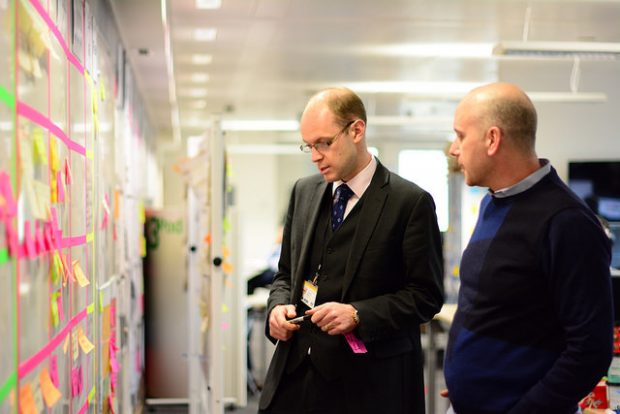 My name’s James Reeve and I’m a senior policy advisor at the Department for Education. For the past 18 months I’ve spent a lot of time travelling to Coventry to work with the team building the apprenticeship service.
My name’s James Reeve and I’m a senior policy advisor at the Department for Education. For the past 18 months I’ve spent a lot of time travelling to Coventry to work with the team building the apprenticeship service.
When the apprenticeship levy was announced in summer 2015, we didn’t have long to deliver it. There wasn’t time to get it wrong – so we invested in doing it right.
It’s unusual to have a policy person embedded in a delivery team, especially from the very start. I started on the project back in December 2015. Then, there were just four of us. Now there are more than 100. We are working quickly, on target, and all set to go live next month. I think co-location has been crucial to our success - in this blog post I’ll explain why.
Don’t design too early
Most of the time, when central government departments want to bring in a new policy, they wear a ‘customer’ hat. Meanwhile, government agencies and private sector suppliers wear a ‘delivery’ hat. In this way government spends about £45 billion each year on things like schools, hospitals and services.
To be a good customer you need to be good at buying things. Policy and delivery teams agree that they both want to get good value for taxpayer’s money. But buying things well is hard to do. That’s why there is an entire industry devoted to procurement.
In the worst-case scenario, government (just like lots of other large organisations) can be an inexperienced customer. Often it is all too easy to concoct a solution before we fully understand the problem. That means the government might ask a supplier to design a particular solution without first exploring what the problem is and what its users need. This can end up costing a lot of money and taking a lot of time, which can lead to a loss of trust between policy and delivery.
A smarter government describes its needs well and negotiates a better price. This makes it an intelligent customer. But all too often, policy passes responsibility for a project to the delivery team, and then forgets to nurture it. This approach relies on flawless articulation of the problem rather than trust. If you do this, you can’t expect the solution to come back perfect. Even the most well-defined project is subject to change or, more likely, misinterpretation.
Build trust
The next step towards maturity is policy-delivery collaboration. This means a two-way conversation about the solution. It takes an investment of time and energy on both sides, but it gets better results, faster. It means building trust (which often isn’t there are the start) and learning from our mistakes in the open. It’s much easier to do this if you are co-located, but if you can’t be, then over-communicate! The benefit is obvious: teams that trust one another spend more time being productive and less time being defensive. Plus, you get the added bonus of policy people understanding user needs and delivery people understanding policy.
Taking the final step is harder. To describe it, I've borrowed the hashtag #oneteam because it’s a mindset, not a structure. I think it has three characteristics:
- Trust between policy teams and delivery teams
- Co-location or over-communication
- Personal sacrifice from those involved to make it happen (because change is hard and you might need to give up your time and energy)
How do we reach #oneteam?
The team building the apprenticeship service has been on this journey for 18 months. During this time, I’ve learnt that co-location is an excellent way to transfer delivery skills and empathy into the policy team. And a great way to ensure the service design team knows everything they need to know about the policy they are delivering. We may not be quite #oneteam, but we are well on our way to that mindset.
The apprenticeship service is currently in public beta and is due to go live in April. If you’re an employer and due to pay the levy in April, you can register for the service now.
If you’re interested in the service and how it’s being built, follow our regular blog updates by signing up to email alerts or our RSS feed. You can also follow @ESFAdigital on Twitter.